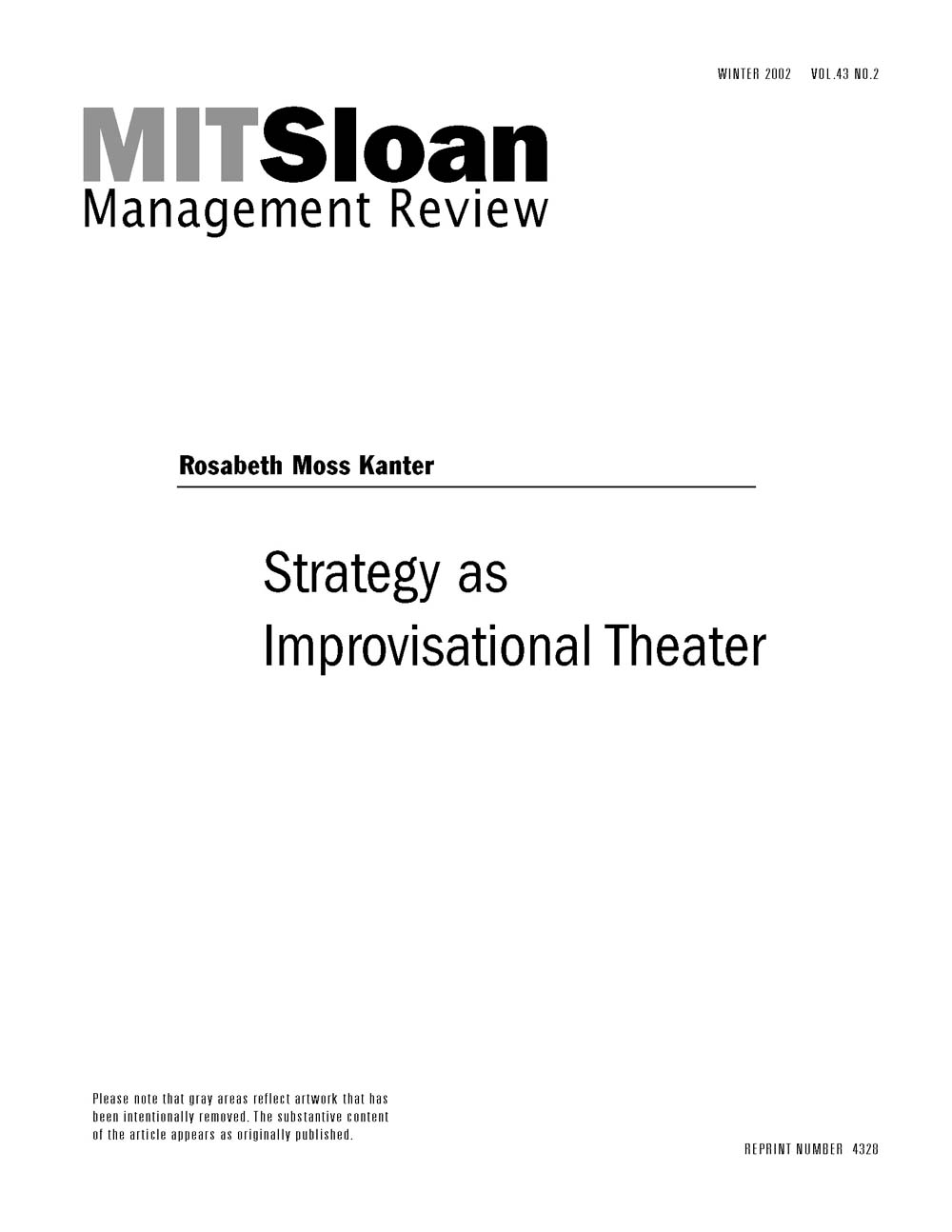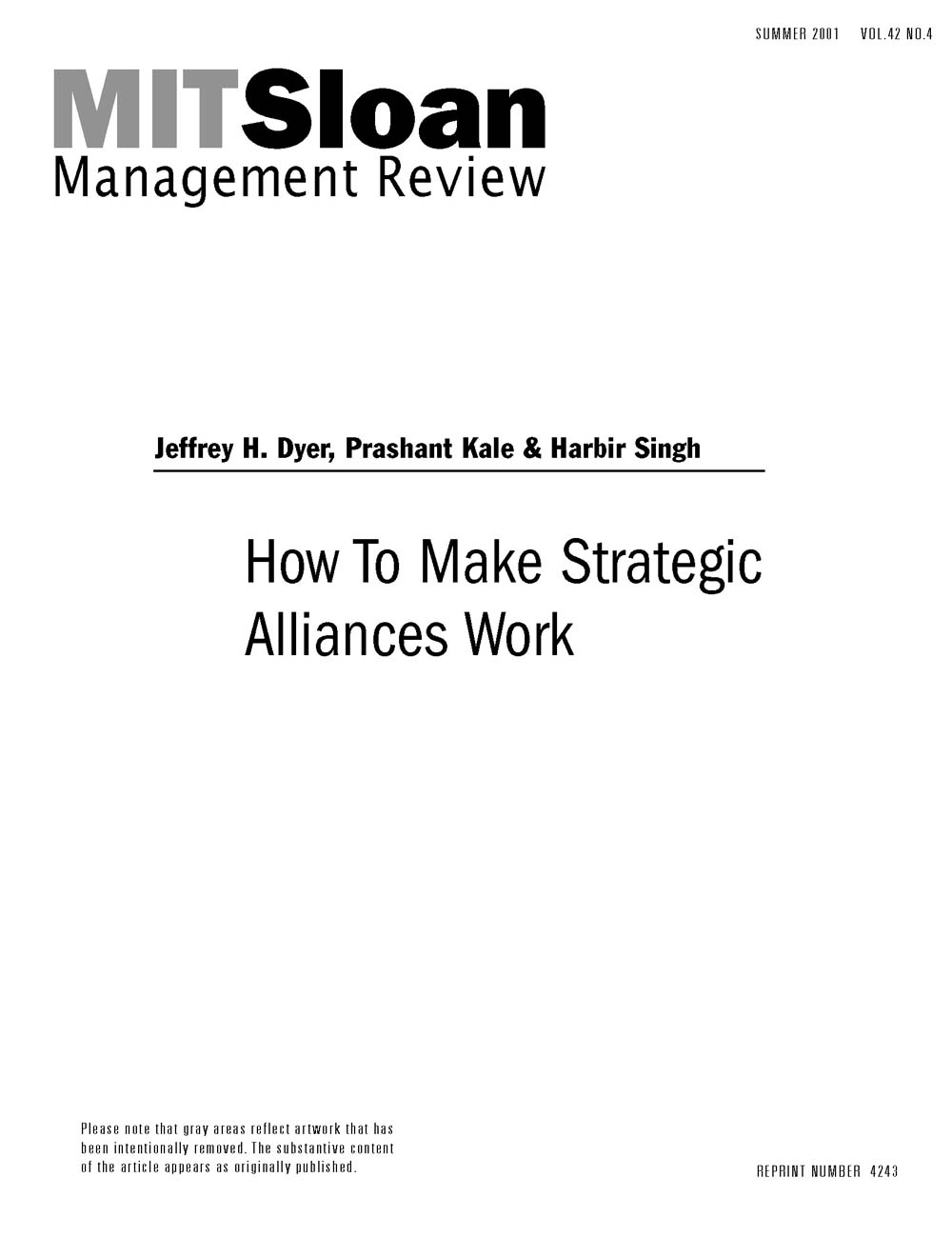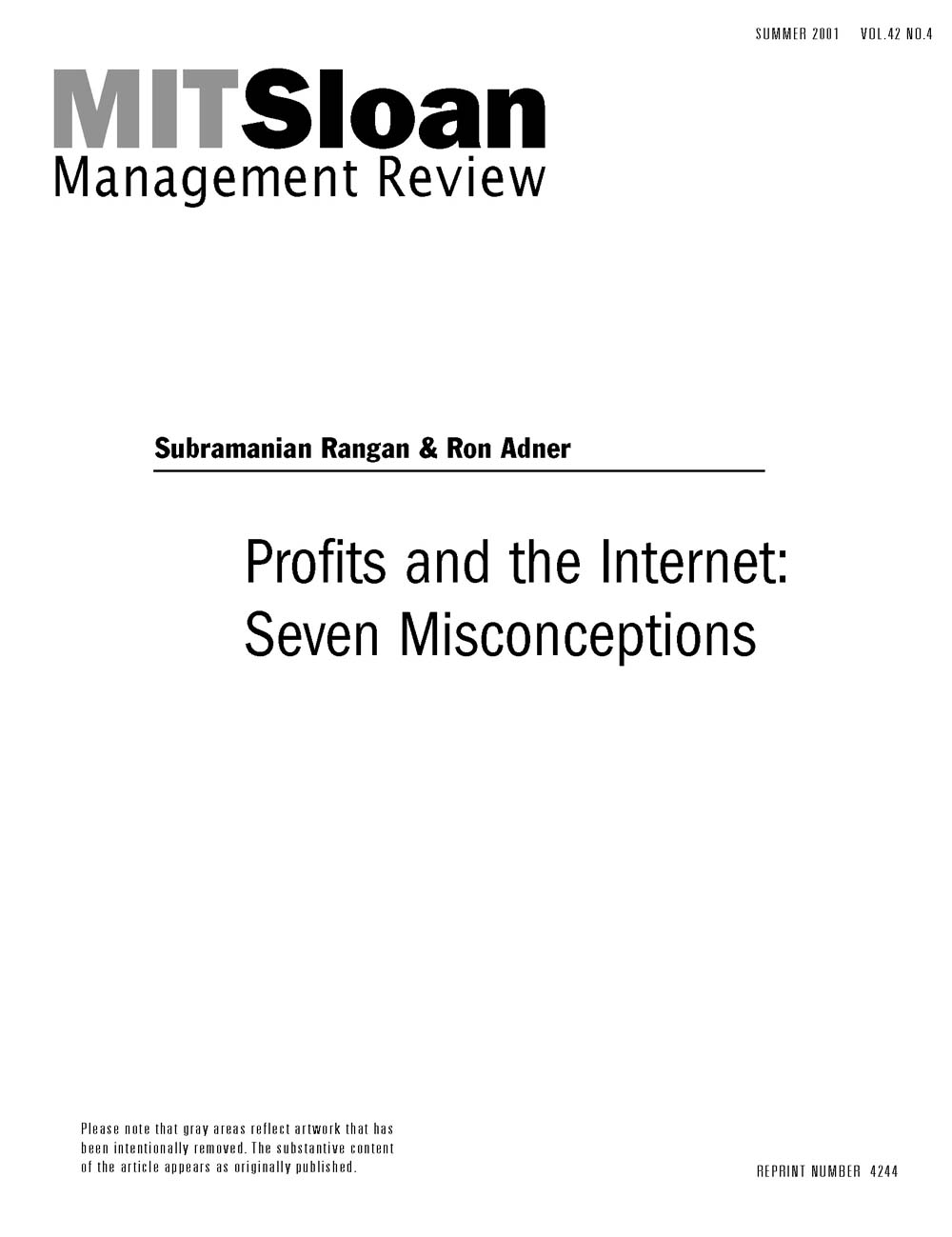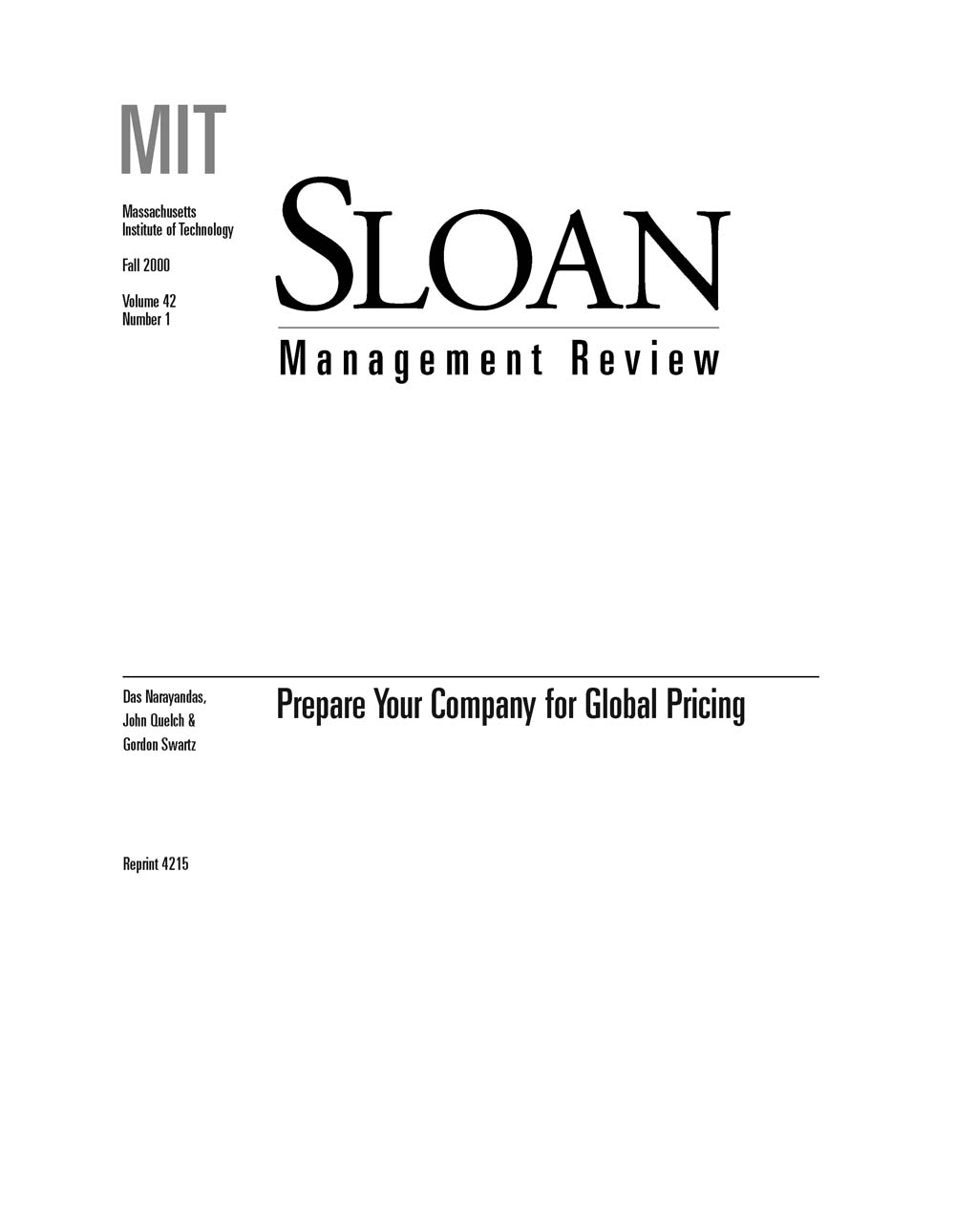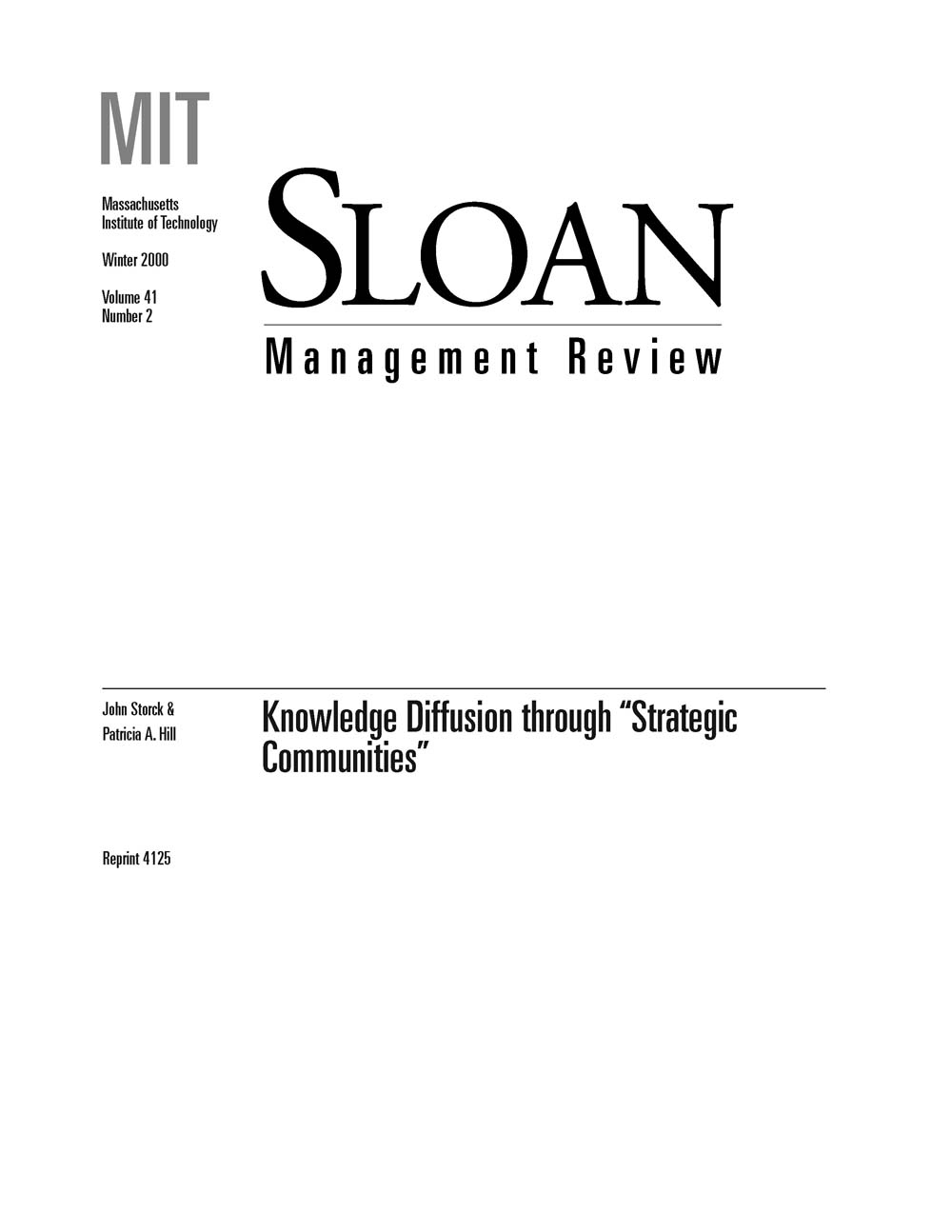Strategy P. 17
Page 40 of 46
-
Strategy as Improvisational Theater
In following the traditional model of strategy development, a company seeks to craft the best possible plan so that it can be handed off for a predetermined course of execution involving a predictable set of events and a specific final goal. This scripted approach resembles traditional theater: The actors speak the same lines and the action comes to the same satisfying conclusion, night after night. The model works well when business is going through a relatively stable period. The current situation, however, is not stable: Companies are still trying to navigate the technological tsunami created by the Internet. Under the circumstances, it makes much more sense for companies to follow an improvisational model & #8212; that is, to throw out the script, bring in the audience and trust the actors to innovate on the spot. The metaphor of improvisational theater helps executives think about the way in which an entire organization can become an arena for staging experiments that can transform a company’s overarching strategy. Harvard Business School professor Rosabeth Moss Kanter lays out the six elements of strategic improvisation and illustrates how companies have made use of each one to get the most out of new technologies. Senior managers who understand these elements can create an atmosphere in which improvisational theater thrives; change then becomes an organic process rather than a painful reaction to circumstances beyond the company’s control. Although this approach does not advocate a big plunge into something totally new, it is anything but conservative. Companies that engage in continual improvisation through innovative projects of all sizes and shapes are much better equipped to explore highly threatening disruptive technologies and embrace quite radical changes.
-
Finding the Right CEO: Why Boards Often Make Poor Choices
Although identifying and hiring the most appropriate CEO is critical to an organization’s success, the succession practices of many large corporations often result in poor outcomes, as recent brief CEO tenures at Coca-Cola, Gillette and Xerox testify. To better understand the dynamics affecting such a complex selection process, from 1995 to 2000 Harvard Business School professor Rakesh Khurana interviewed scores of directors, executive-search consultants and job candidates about the methods that large corporations use when hiring a CEO. In the process, he discovered several common pitfalls that derail efforts to find the right CEO. He observes that a variety of practices are nearly institutionalized in many companies, and he explains ways to avoid them. Khurana also contends that boards can actively manage the following aspects of a CEO search and greatly improve the likelihood that the survivor who emerges is best suited for the challenges of the job. Search-committee composition. Khurana recommends that the search committee consist of a diverse group, not only in terms of age and functional background but also concerning knowledge of the company and its culture. The “CEO as panacea” syndrome. Boards must be sure to consider the contributions of other executives in company success; failure to do so will raise expectations about the performance of the incoming CEO to an unsustainable level. Adoption of outcome-oriented practices. According to Khurana, the practices most relevant to a successful outcome are discussing the company’s strategic direction explicitly and early in the process; recognizing and defining search participants’ roles and responsibilities (in particular, limiting the roles of the outgoing CEO and the executive-search firm); and evaluating candidates in light of the position’s requirements, rather than in relation to one another.
-
Mastering Strategic Movement at Palm
Whether you’re a startup taking on industry giants or a giant moving into markets dominated by powerful incumbents, how do you compete with opponents that have size, strength and history on their side? To prevent opponents from bringing their full strength into play, successful challengers use what authors David B. Yoffie and Mary Kwak of Harvard Business School call judo strategy. Judo strategists avoid head-to-head struggles and other trials of strength, which they are likely to lose. Instead, by relying on speed, agility and creative thinking, they develop strategies that make it difficult for stronger rivals to compete. Judo strategy is most effective when three core principles & #8212; movement, balance and leverage & #8212; are used in combination. But at different stages of competition, a single principle may play a particularly important role. In the early days of a business, for example, before the contours of the competitive landscape have been fully defined, movement typically takes center stage. The authors use Palm Computing (now Palm Inc.) to illustrate judo strategy’s core principle of movement at work. The company dominated the handheld computing market less than a year after shipping its first electronic organizer in early 1996, despite competition from the most powerful software company in the world. Microsoft marshaled masses of money, manpower and marketing muscle behind its own handheld operating system. But year after year, Palm remained far ahead. By mastering the principles of judo strategy and learning to implement them through specific techniques, other companies can emulate the way Palm competed with a stronger opponent. The authors came to that conclusion after studying companies as varied as Juniper Networks, Intuit, Frontier Airlines and Charles Schwab. They caution, however, that judo strategy is not a rigid formula to be followed step by step. Depending on the nature of their competition, companies will combine and implement the principles in different ways. But the basic tenets hold: Stay out of competitors’ sights by deliberately acting harmless (like a puppy dog), define the competitive space to establish the game, and follow through fast to build a big lead before competitors learn how to respond.
-
How To Make Strategic Alliances Work
New research shows that among today’s numerous strategic alliances, the most successful are in companies with a department specifically assigned to overseeing alliances. Management professors Jeffrey H. Dyer, Prashant Kale and Harbir Singh came to that conclusion after conducting an in-depth study of 200 corporations and their 1,572 alliances. The number of strategic alliances has increased dramatically over the past decade, with more than 20,000 reported during the last two years alone. On average, the top 500 global companies each participate in 60 major strategic alliances. Fraught with risk, almost half fail. The authors set out to discover why some companies manage alliances effectively when others fail. They found that organizations such as Hewlett-Packard, Oracle, Eli Lilly & ; Co. and Parke Davis, which excel at generating value from alliances, have a dedicated strategic-alliance function. Companies with a dedicated function were better at solving problems related to the four key alliance-management elements & #8212; knowledge management, external visibility, internal coordination and accountability. A dedicated function, the authors show, acts as a focal point for learning and for leveraging feedback from prior and ongoing alliances. It systematically establishes processes to articulate, document, codify and share alliance know-how. The authors found that one benefit of creating an alliance function was that it compelled companies to create metrics for evaluating the performance of all their alliances. And regular evaluations alerted senior managers to intervene when a particular alliance was struggling. Many companies with dedicated alliance functions report codifying alliance-management knowledge. They create guidelines to help with specific aspects of the alliance life cycle, such as partner selection or alliance negotiation. Some companies establish training programs, both formal ones and informal ones & #8212; such as roundtables that let managers of various alliances share their experience. When done properly, dedicated alliance functions offer internal legitimacy to alliances, assist in setting strategic priorities and draw on resources across the company. That is why, the authors advise, the function cannot be buried within a particular division or be relegated to low-level support within business development.
-
Profits and the Internet: Seven Misconceptions
The Internet has created new markets, customers, products and modes of conducting business. But it also has given currency to some dangerous half-truths. Admonishing Internet businesses to “stop grabbing the land and start cultivating it,” Subramanian Rangan and Ron Adner, professors of management and strategy at INSEAD in France, explain why seven popular strategies are not the path to profitable growth. First-mover advantage, for example, gets too much credit for e-business success. Companies believe that they can lock in customers and trigger a winner-take-all dynamic, but there is no guarantee that those benefits will go to first movers. The allure of reach & #8212; increasing the number of customer segments & #8212; causes many companies to ignore fit, the coherence with which their activities reinforce one another. Digital Equipment Corp. paid the price when it sacrificed fit to reach, attempting to make PCs, workstations, minicomputers and mainframes under one roof. Another tempting growth strategy is to provide customer solutions, offering products or services that complement a company’s core offering. But offering solutions can dilute a company’s focus. Targeting the right Internet sector is one way to maintain focus. When companies view the Internet as undifferentiated landscape, they are less able to distinguish the drivers of customer value and performance & #8212; or the metrics to measure them. Some companies see best-of-breed-partner leverage as the secret of profitable growth. But although the Internet makes it easier and cheaper to align activities across company boundaries, it does not do much to align interests & #8212; a requirement for the creation of joint value. Another misconception is the belief that an Internet business will automatically be successful abroad. As MTV, Wal-Mart and Honda discovered, companies first must be successful at home and then move outward in a way that accommodates local differences. The last, and perhaps most dangerous, misconception is managers’ belief that technology can substitute for strategy. Technology and strategy are strong complements. Companies that understand their technology better than they understand their customers and competition won’t succeed in any economy, old or new. The authors provide thoughtful guidelines for avoiding misconceptions and taking a sensible approach to business on the Internet.
-
Prepare Your Company for Global Pricing
As adapting to globalization becomes increasingly necessary, business customers are pressuring suppliers to accept global-pricing contracts (GPCs). So far, most of the benefits of GPCs have redounded to the business customer. Although purchasers may promise a supplier access to international markets, guaranteed production volumes and improved economies of scale and scope, too often they fail to deliver. They may not buy as much as planned, may demand customization that the supplier cannot leverage with other customers, may force the supplier to drop the customer's competitors -- or may fall on hard times and have to scale back commitments. That is why, before signing a contract, suppliers should do due diligence. According to Das Narayandas of Harvard Business School, John Quelch of the London Business School and Gordon Swartz of Oxford Associates, suppliers must fully understand the customer's global strategy and the business conditions in its respective markets. They also need a firm grasp of their own strategy and local practices. Which GPCs would be suitable and which would be detrimental? Suppliers don't want to turn down all GPCs. They recognize that their global customers may be both their largest customers and their fastest growing ones -- and understandably, they want to share in the benefits of growth. Using data collected from interviews with global-account managers in diverse industries on four continents, the authors bring the global concepts down to earth to help suppliers navigate the uneven terrain. By exploring why customers want GPCs, under what circumstances the contracts are likely to profit suppliers, and how to successfully implement contracts, Narayandas and his colleagues identify preparation as the key to success. The more information suppliers can gather (for example, about variances in their own pricing in different markets, about the cost to serve the customer, about exchange rates and local regulations), the better their negotiating position. During negotiations, it might be useful to know whether the customer demands the same price in every market regardless of the supplier's varying costs -- yet continues to charge its own customers varying prices. A carefully negotiated GPC can be a winning outcome for both supplier and customer and can serve as the foundation for a broader, mutually advantageous relationship that extends beyond price.
-
Knowledge Diffusion through "Strategic Communities"
When faced with a global IT infrastructure transition project, Xerox managers decided to launch a knowledge-sharing initiative called the Transition Alliance. When fully functional, the Alliance comprised fifty IT professionals responsible for managing 70,000 desktop workstations, nearly 1,200 servers, and networking hardware on five continents. Storck and Hill observed that community members provided high-quality, validated solutions; handled unstructured problems well; and dealt effectively with new developments in hardware and software. The authors also point out that the motivation for learning and developing at an individual level seemed greater in this community structure than in other organizational forms, which has important implications for the longer-term job performance of the participants. The Alliance was more than simply a group that met occasionally to discuss common issues related to a single functional or professional area. It had a defined relationship to formal organizational objectives yet was not formally required to report back to headquarters on its activities. Within the Alliance, the communication repertoire was built upon the leadership training required for all Xerox employees. Work processes that developed within the Alliance supplemented those used elsewhere in the organization. Handling action items, creating meeting agendas, and developing other processes were evidence of the self-directed nature of the group and provided a context for communication. Storck and Hill identified six guiding principles that were instrumental to Alliance success and are applicable whenever circumstances require organizational learning: -- Design an interaction format that promotes openness and allows for serendipity. -- Build upon a common organizational culture. -- Demonstrate the existence of mutual interests after the initial success at resolving issues and achieving corporate goals. -- Leverage those aspects of the organizational culture that respect the value of collective learning. -- Embed knowledge-sharing practices into the work processes of the group. -- Establish an environment in which knowledge sharing is based on processes and cultural norms that are defined by the community rather than other parts of the organization.




